Important Updates, UPSC MAINS 2020 QUESTION PAPERS
Dear Aspirants,
What do you think real happiness is? For us, it is the sense of achievement which one receives after putting in efforts to get something and then reaping the desired results. Today we would like to share our happiness with you.
For the past 6 years, we have been doing one thing with great passion and dedication. Yes! We love to guide the Civil Service aspirants. We have channelised all our energies and dedicated all our efforts into creating an ecosystem that gives every aspirant a chance to crack the prestigious civil services examination with Rank-1, even if he/she is in the remotest corner of the country. In this process, we have developed, designed, and dedicated a series of initiatives for Civil Services Exam preparation.
The quality of these initiatives has been proven time and again. It has become a norm to have high Hit Ratios in Prelims and Mains from the initiatives of IASbaba, namely Integrated Learning Programme (ILP) and Think Learn and Perform (TLP).
For the last 6 years, we have managed to hit the bull’s eye when it comes to GS Mains papers.
This article is not to boast about the Hit Ratio of our initiatives in any case. It would not be right to say that these many questions, directly or indirectly came from our initiatives just by using keywords of the UPSC questions. In that way, if we frame questions over the year on all keywords in the UPSC syllabus our hit ratio will be 100%. However, you are smart enough to analyse the importance of our initiatives and its very close resemblance to actual UPSC papers.
Rather than focusing on the numbers try to focus on the significance of these initiatives and make them a part of your preparation. Hard work should be done smartly to have a better Input-Output ratio of efforts and results.
Below we have come up with the Analysis and Approach for each question of General Studies (GS) Paper 3 that was asked by UPSC along with the links and references of IASbaba questions/ articles. After going through this article, you will realise that just by sincerely following the initiatives on our platform, your chances of success in the Mains stage would have increased dramatically.
[QUESTION PAPER] GENERAL STUDIES PAPER 3 (GS3) – UPSC CIVIL SERVICES (CSE) MAINS EXAMINATION 2020 – CLICK HERE
NOTE: PDF of Analysis is provided at the end of the post.
[VIDEO] GS1 GS2, GS3, GS4 & ESSAY ANALYSIS – UPSC MAINS 2020 by IASbaba -> CLICK HERE
OVERVIEW of GENERAL STUDIES (GS) PAPER 3:
Overall, the General Studies Paper 3 this year was moderate considering last year’s paper, except for three-four technical questions which an aspirant would have found it difficult to answer in those 3 hours. Also, the questions are not lengthy, which is an added advantage to finish this paper in three hours.
Indian Economy (1, 2, 3, 4, 11, 12, 13, and 14): Questions 13 & 14 are based on agriculture which are easy to moderate. Questions 1, 2, 11, and 12 are based on the economic situation of the country and are more on the analytical side. Questions 3 and 4 are based on food grain distribution and food processing. Both these questions are about the steps taken and policy measures by the Government. These questions are easy in nature.
Science and Technology (5, 6, 15, and 16): Question 16 is on the easier side, whereas question 15 is a difficult question because of its specificity. Question number 6 can be considered an easy to moderate level question.
Environment (7, 8, and 17): Three questions have been asked from this part. While one of them is based on a static concept, the other two are based on one of the current threats (Jal Shakti & Air Program) to the environment. These questions can be easily answered by the aspirants.
Disaster Management (18): Only one question has been asked from this part. The question on Disaster Management is a specific question.
Internal Security (9, 10, 19, and 20): Four questions have been asked from this part. One of them on Cyber-crimes can be considered as a difficult question as it is very specific and one can answer only if they have prior knowledge about that question. The other three questions are of moderate level.
Q.1) Explain intergenerational and intragenerational issues of equity from the perspective of inclusive growth and sustainable growth. (Answer in 150 words.)
LINE OF THOUGHT / APPROACH:
This question demands clarity of concepts like equity, inclusive growth. The introduction can be with definitions of the above concepts. Need to write issues of intergenerational, intragenerational like access and use of resources, opportunity, etc. Also here you need to write what needs to be done in this direction and measures taken so far. The conclusion can be optimistic that disparity is reducing with the above steps
IASBABA REFERENCE:
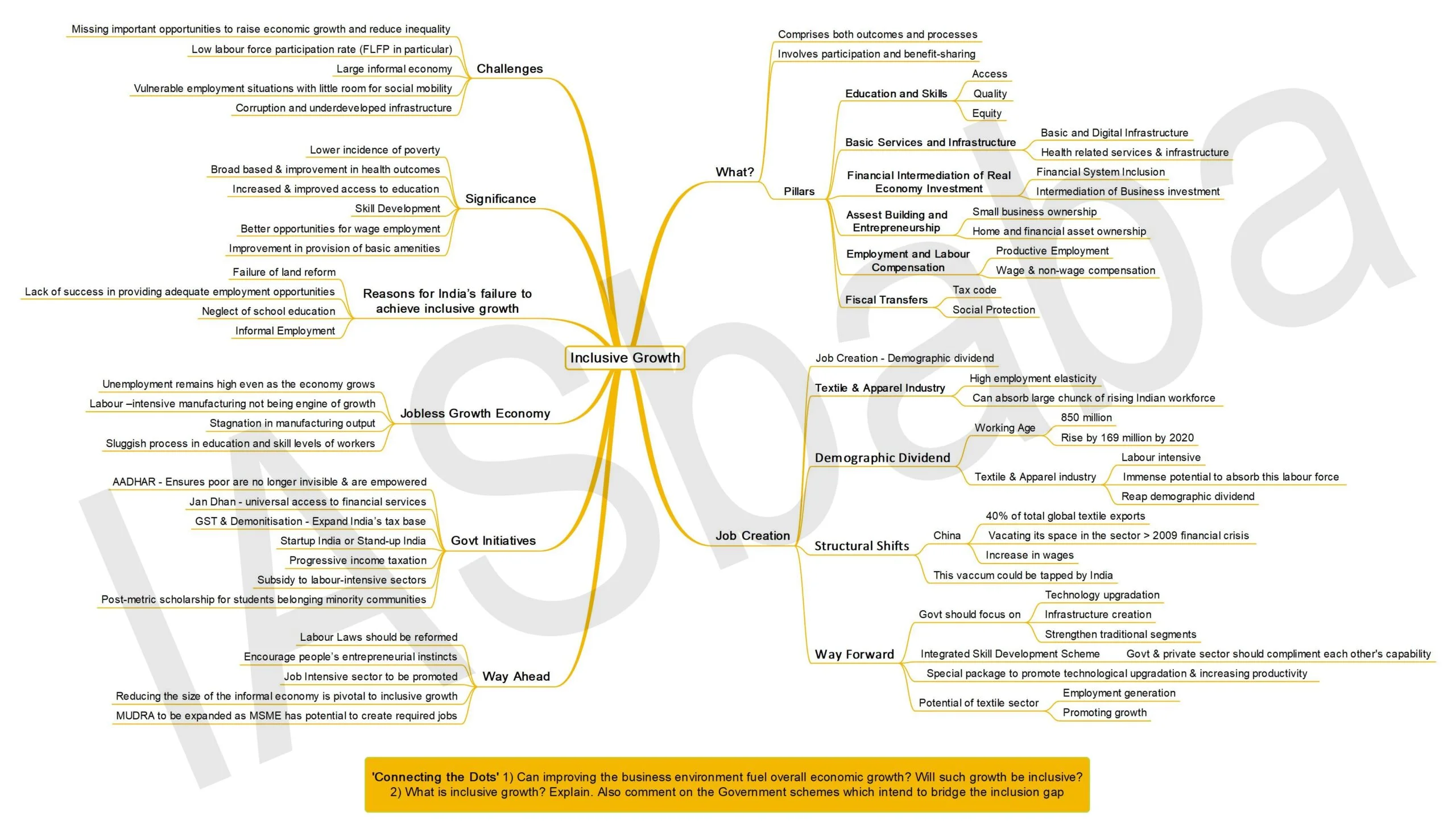
Q.2) Define potential GDP and its determinants. What are the factors that have been inhibiting India from realizing its potential GDP? (Answer in 150 words.)
LINE OF THOUGHT/APPROACH:
It is a direct question. Students here need to address all demands. Write what potential GDP, Determinants are. Also, with equal weightage to an answer write the last part – inhibiting factor. Here clarity in thoughts, concepts should reflect in an answer. The conclusion can be done with measures needed for achieving potential GDP.
Q.3) What are the main constraints in transports and marketing of agricultural produce in India? (Answer in 150 words.)
LINE OF THOUGHT/APPROACH:
Students need to apply here the application of content/ knowledge they have. Introduce an answer by writing important factors in good agricultural production or supply chain in agriculture. Constraints in transportation and marketing specifically need to be written. The conclusion can be in short, any recent measures by the government in this regard.
IASBABA APPROACH:
Q.4) What are the challenges and opportunities in food processing sector in the country? How can income of the farmers can sustainably be increased by encouraging food processing? (Answer in 150 words.)
LINE OF THOUGHT / APPROACH:
Students are expected to write all parts distinctly. Write challenges- infrastructure, skilling, etc. Opportunities- India is the leading producer of many agricultural produces. Also need to write- ways of encouraging food processing- Initiative like SAMPADA can be mentioned.
IASBABA REFERENCE:


Q.5) What do you understand by nanotechnology? And how its helping in health sector? (Answer in 150 words.)
LINE OF THOUGHT/ APPROACH:
Again, a very direct question where students need to write about nanotechnology. The introduction can be defining or briefly writing about nano technology. Distinctly write benefits in the health sector. Here specific application/points are expected, like – diagnosis, medications, etc.
IASBABA REFERENCE:
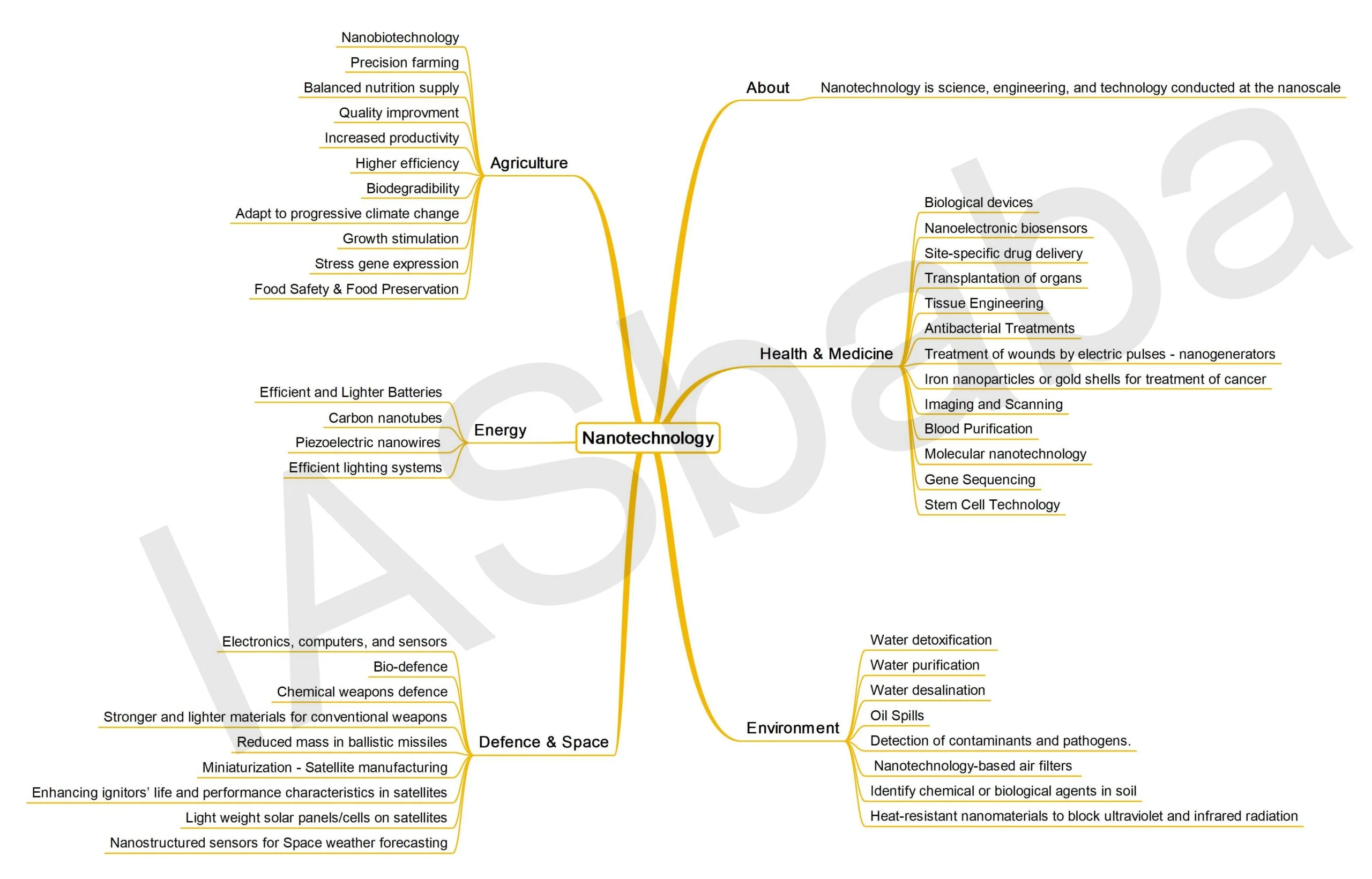
Q.6) How is science interwoven deeply with our lives? What are the striking changes in agriculture triggered off by the science-based technologies? (Answer in 150 words)
LINE OF THOUGHT/APPROACH:
This is a direct question on how science & technology is shaping our lives.
In the first part of answer, one can elaborate on technology is playing a crucial role in all aspects of lives – Political (e-governance), Economical (digital payments simplified transactions), Social (interactions via email, social media), health (diagnostics), education (MOOCs), transport (driverless cars), communication (satellite technology) and Culture (usage of green crackers)
The second half of the answer has to specifically deal with technology’s intervention with agriculture. Here you can use how technology is being used at all three stages of agricultural activity – Input stage (GM seeds, Soil Health Card, Kisan Credit cards, digitisation of land records), farming stage (weather forecasting using satellite technology, usage of modern equipments, drip irrigation, fertigation) and Post-harvest Stages (e-NAM, price prediction technologies, smart warehouse management etc.)
Conclude by mentioning, in brief, the pitfalls of technology (affordability, accessibility, corporate capture) and mention that Indian agriculture still has a long way in fully embracing technology.
IASBABA REFERENCE:

Q.7) How does the draft Environment Impact Assessment (EIA) Notification, 2020 differ from the existing EIA Notification, 2006? (Answer in 150 words)
LINE OF THOUGHT/APPROACH:
This is a straightforward question directly sourced from Current Affairs. First, mention what is EIA and the significance of having it.
Then, mention about the changes that were brought in EIA,2020 notification (you can find it in below links)
Conclude the answer by mentioning the criticism of 2020 notifications and steps that can be taken to overcome it.
IASBABA REFERENCE:
https://iasbaba.com/2020/06/environment-impact-assessmenteia-part-2/
https://iasbaba.com/2020/08/eia-notification-2020-what-are-the-key-changes/
Q.8) What are the salient features of the Jal Shakti Abhiyan launched by the Government of India for water conservation and water security? (Answer in 150 words)
LINE OF THOUGHT/APPROACH:
This is also a direct question about government schemes & policies. Jal Shakti Abhiyan (JSA) was launched in mid-2019 that aims at making water conservation a Jan Andolan through asset creation and extensive communication.
Jal Shakti Abhiyan strives for water conservation and water resource management by focusing on the accelerated implementation of five target interventions.
- Water Conservation and rainwater harvesting
- Renovation of traditional and other water bodies/tanks
- Reuse and Recharge structures
- Watershed development
- Intensive afforestation
Along with these targeted areas, it also has Special area intervention areas like
- Block and district water conservation plan
- Krishi Vigyan Kendra Mela
- Urban Wastewater reuse
- 3D Village Contour mapping
- Use of Scientists and India’s premier Institutes
The answer can also mention in brief about the water problems faced by India (using flowchart) before beginning with the elaboration of the JSA.
Finally, conclude by saying that implementation by authorities and civic participation is the key to achieve success
IASBABA REFERENCE:
https://iasbaba.com/2019/07/all-india-radio-air-ias-upsc-significance-of-jal-shakti-abhiyan/
Q.9) Discuss different types of Cybercrimes and measures required to be taken to fight the menace. (Answer in 150 words)
LINE OF THOUGHT/APPROACH:
This question in the light of increased cybercrimes across the world including that in India (ex: Pegasus attack)
Start your answer by mentioning the various types of Cybercrimes like Phishing, spamming, virus dissemination, credit card hacking, software piracy, cyberstalking, cyber terrorism, identity theft, hacking, pornography, denial of service etc.
Later you can mention in brief (maybe using flowchart) about challenges in India’s cybersecurity strategy- lack of coordination, delay in National Cyber Security Strategy, lack of proactiveness, inadequate modernization of computer systems, dependency on foreign players for cybersecurity tools i.e. capabilities issue, lack of awareness etc.
In the second half of the answer mention the steps that need to be taken to fight the menace – regulatory (legislation), administrative (effective monitoring & oversight), federal (dedicated cadre, training of personnel & smooth coordination between different levels), infrastructural (modernisation of cyberinfrastructure), economic measures (incentives for cybersecurity players), public awareness (about cybercrimes) etc.
Conclude by mentioning the significance of Cybersecurity for India’s dream of achieving a $5 trillion economy.
IASBABA REFERENCE:
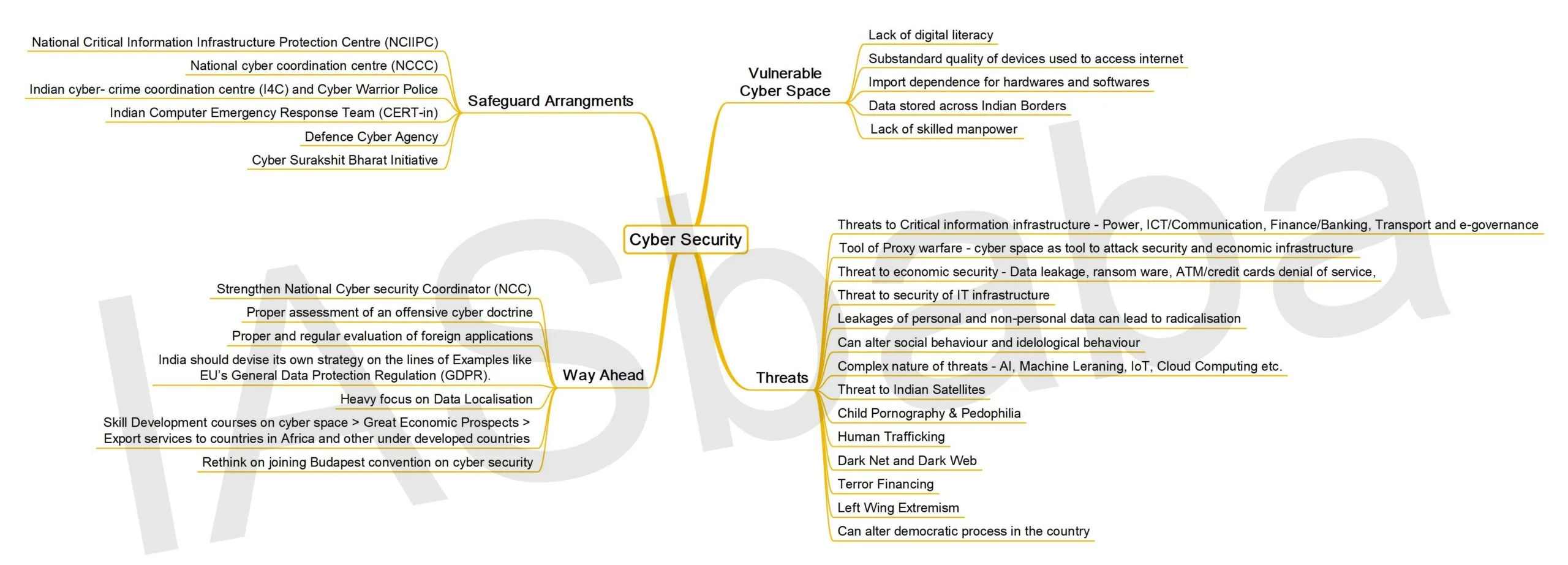
Q.10) For effective border area management, discuss the steps required to be taken to deny local support to militants and also suggest ways to manage favourable perception among locals. (Answer in 150 words)
LINE OF THOUGHT/APPROACH:
This is a question about the interlinkage of society and security.
First mention the reasons as to why local people support militants:
- Historical -Kashmir militancy, Naga issue
- economic factors: lack of jobs, poverty, imbalance in regional development, inequality in society
- Political – lack of local people representatives in decision making of management of border areas, vote bank politics
- Social factors – feeling of alienation due to weak integration with mainstream India ex North East Insurgency
- Inefficient Governance: Corruption at local level leading to feeling of looting of resources, also lack of effective communication with locals by those in Power (failure to interact regularly)
The second half of answer should deal with measure to overcome negative perception among locals
- Political- Grassroots democracy i.e. involving locals to decision making; exposing the identity politics that try to reap benefit of anti-national sentiments
- Economic- Providing jobs and bridging developmental gap in the region
- Public Diplomacy – persuading celebrities and apolitical social leaders to convey the message & policies of government
- Crackdown on corruption at local level
- Regular interaction with mainstream India (Ek bharat Shrest Bharat campaign)
Conclude by saying that managing locals will go a long way in managing border areas as intelligence network will be strengthened and issues of militancy will be nipped in the beginning stage itself by community support.
IASBABA REFERENCE:
Q.11) Explain the meaning of investment in an economy in terms of capital formation. Discuss the factors to be considered while designing a concession agreement between a public entity and private entity. (Answer in 250 words)
LINE OF THOUGHT / APPROACH:
Students here needs sound understanding of investment and capital formation. Link is Gross Capital Formation. In the second half of the answer write what the concession agreement is. Factors in it – Terms of the agreement, dispute resolution, Risk-sharing, etc.
Q.12) Explain the rationale behind Goods and Services Tax (Compensation to states) act of 2017. How has COVID-19 impacted the GST compensation fund and created new federal tensions? (Answer in 250 words)
LINE OF THOUGHT/ APPROACH:
Briefly introduce GST – rationalized one nation one tax.
With a distinct heading write rationale. Application-based addressing of the second part is required. New federal tensions- central failed or lacked in giving GST compensations to states. Federal strains in financial fields surfaced. The conclusion can be done in an optimistic way, yes the central government has taken measures with the world bank and came up with a dedicated fund.
IAS BABA REFERENCE:
https://iasbaba.com/2020/10/centre-to-borrow-on-behalf-of-states-to-meet-the-gst-shortfall/

Q.13) What are the major factors responsible for making the rice-wheat system a success? In spite of this success, how has this system become a bane in India? (Answer in 250 words)
LINE OF THOUGHT/ APPROACH:
In the introduction, students need to briefly write about what is the rice-wheat system. It’s a highly practiced cropping pattern. Factors being – climate, result, and easy practicing of this cropping pattern. Shortcomings of this system can be more water requirements among others. The conclusion can be how to improve this particular system- diversifying cropping pattern on a sustainable basis.
IASBABA REFERENCE:
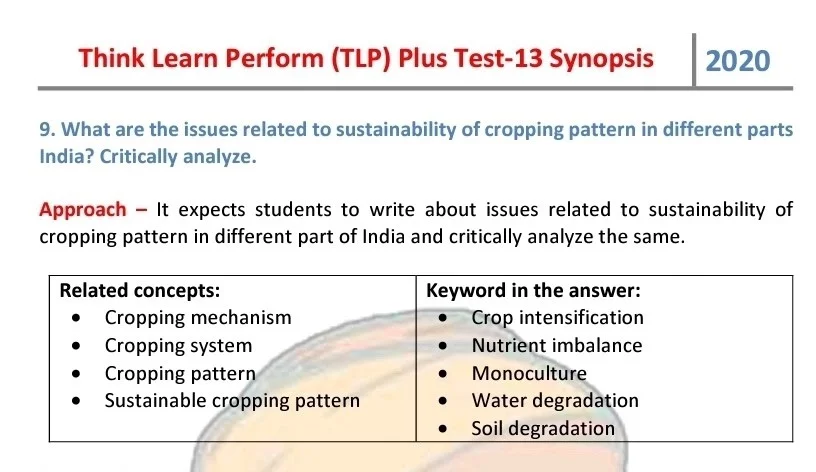
Question asked in TLP test 13 2020 Question 9
Q.14) Suggest measures to improve water storage and irrigation system to make its judicious use under depleting scenario. (Answer in 250 words)
LINE OF THOUGHT/ APPROACH:
It is again a direct question with possibly open-ended dimensions. Here students have to make specific analysis with content, facts and case studies. The introduction can be what is the status of the depleting scenario. By 2025 India can be a water-stressed country from water-scarce status. In this regard need of reforming the water storage and irrigation system. Irrigation measures like precision irrigation can be suggested.
Conclusion – SDG goal can be mentioned here.
IASBABA REFERENCE:
Q.15) COVID-19 pandemic has caused unprecedented devastation worldwide. However, technological advancements are being availed readily to win over the crises. Give an account of how technology was sought to aid the management of the Pandemic. (Answer in 250 words)
LINE OF THOUGHT / APPROACH:
Good application-based question is asked.
Many and diversified examples can be given. Technology aid during a pandemic- Video summit (international, national)- saving government expenditure unnecessary. Telemedicine. Etc. Conclusion – The good changes technology brought should be continued in the future which will definitely ensure sustainability in many ways.
IASBABA REFERENCE:
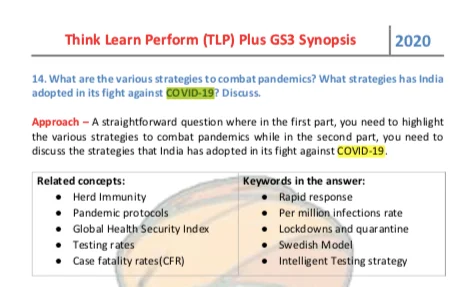
Q.16) Describe the benefits of deriving electric energy from sunlight in contrast to conventional energy generation. What are the initiatives offered by our government for this purpose? (Answer in 250 words)
LINE OF THOUGHT/ APPROACH:
There are two parts in the question; the first part asks to provide the advantages of deriving electric power from solar energy. Second part is a direct one it demands to provide the government initiatives for the effective harness of solar-electric power.
For the first part we can bring in facts like the amount of solar power incident in India, and the cost saved in manufacturing solar cells over hydel or thermal power plants so on. We can also mention the advantages for the environment i.e. reduction in pollution etc.
In the second part we can provide National Solar Mission, encouragement by the government to the assemblage of solar cells and panels in India, KUSUM project, Rooftop solar projects,etc. Further, we can provide some examples like Naramda canal top solar power plant, setting up of largest solar power plant in Karnataka and others.
Lastly, we can conclude with the Government of India’s target in the solar energy sector and the International solar alliance.
IASBABA REFERENCE:
IASbaba TLP PLUS Test 16
Q.15. India’s energy future is highly dependent on renewables. In this light, examine, the progress made and current impediments towards the realization of an entry secure future.
https://iasbaba.com/2020/08/indias-solar-energy-push-the-big-picture-rstv-ias-upsc/
Q.17) What are the features of the National Clean Air Programme (NCAP) initiated by the government of India? (Answer in 250 words)
LINE OF THOUGHT/ APPROACH:
A direct question, it asks to list out the features of the National Clean Air Programme, here we need to provide precise features with specific targets and statistics in order to get the maximum marks.
Examples like: the program aims to attain 20 to 30% reduction in particulate matter by 2024, by taking 2017 as the base year.
We can conclude by mentioning some initiatives like the SAFAR, Water sprayers in Delhi, etc.
IASBABA REFERENCE:
https://iasbaba.com/2020/09/national-clean-air-programme-to-be-modified/
https://iasbaba.com/2019/02/daily-current-affairs-ias-upsc-prelims-and-mains-exam-30th-january-2019/

IASbaba TLP PLUS Test 18
Should air pollution be considered a ‘disaster’? Comment. What mitigative measures would you suggest to address the problem of worsening air quality in Indian cities?

Q.18) Discuss the recent measures initiated in the disaster management by the Government of India departing from the earlier reactive approach. (Answer in 250 words)
LINE OF THOUGHT/ APPROACH:
The question puts forth a demand to provide those measures of the Government of India regarding the disaster management which is different from earlier conventional measures. In other words, the earlier disaster management strategy of India involved rescue, relief and rehabilitation; how the recent measures propound the ethos of prediction, prevention and protection.
Here we can include some of the measures like:
Amending the National Disaster Response Framework to include mitigation as one of the strategies.
Finance Commission’s recommendation of National Disaster Mitigation Fund.
We can also include the seismic zoning map in Assam.
Involvement of home guards and civilians rather than depending on the military personnel can also be quoted.
IASBABA REFERENCE:
Q.19) What are the determinants of left -wing extremism in Eastern part of India? What strategy should the Government of India, civil administration and security forces adopt to counter the threat in the affected areas? (Answer in 250 words)
LINE OF THOUGHT/ APPROACH:
There are two parts in the question, the first part asks to bring out the determining factors for the rise of left-wing extremism in the Eastern part of India.
Here we can mention failure of land reforms – Naxalbari incident, underdevelopment, tyranny by the military personnel – AFSPA, etc.
In the second part we need to suggest strategies of action for the given 3 bodies of governance.
Government of India – proper funding and implementation of National Policy on Left Wing Extremism -2007
Civil Administration – profound percolation of government benefits under Integrated Action Plan, to come up with innovative schemes like MITANIN, etc.
Security: to use powers with restraint, come up with battalions like Greyhounds, CoBRA, etc.
IASBABA REFERENCE:
IASbaba TLP PLUS test 6
Regional connectivity and cultural identification are imperative for assuaging the feeling of alienation in the Northeast. Analyse.

Q.20) Analyse internal security threats and transborder crimes along Myanmar, Bangladesh and Pakistan borders including Line of Control (LoC). Also, discuss the role played by various security forces in this regard. (Answer in 250 words)
LINE OF THOUGHT/ APPROACH:
There are two parts to the question;
Structure the 1st part into 3 sections – Myanmar, Bangladesh, and Pakistan; and provide transborder threats and crimes specific to those regions. Here we need to provide good statistics and examples. Ex: increase in the counterfeit currencies at the borders after the oncoming of new currency notes, etc.
In the second part, we need to mention examples of CIBMS, Bold QUIT, Integrated Check posts, Operation Meghdoot, etc.
IASBABA REFERENCE:
IASbaba TLP PLUS test 2
India has to walk the diplomatic tightrope for balancing its domestic priorities with the need to have stable relations with the neighbours.
IASbaba TLP PLUS test 8
Expansion of physical infrastructure in the Northeast has huge local and regional (in terms of India’s cross border ties) significance. Comment. In this light, examine the initiatives taken by the central government.
Download the PDF of GS 3 Analysis here -> CLICK HERE
[VIDEO] GS1 GS2, GS3, GS4 & ESSAY ANALYSIS – UPSC MAINS 2020 by IASbaba -> CLICK HERE
Thank You
IASbaba














